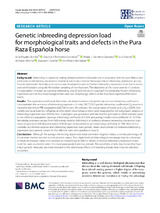Mostrar el registro sencillo del ítem
Genetic inbreeding depression load for morphological traits and defects in the Pura Raza Española horse
| dc.contributor.author | Poyato-Bonilla, J. | |
| dc.contributor.author | Perdomo-González, Davinia I. | |
| dc.contributor.author | Sánchez Guerrero, María José | |
| dc.contributor.author | Varona, L. | |
| dc.contributor.author | Molina Alcalá, Antonio | |
| dc.contributor.author | Casellas, J. | |
| dc.contributor.author | Valera, M. | |
| dc.date.accessioned | 2024-04-03T10:18:16Z | |
| dc.date.available | 2024-04-03T10:18:16Z | |
| dc.date.issued | 2020 | |
| dc.identifier.uri | http://hdl.handle.net/10396/27787 | |
| dc.description.abstract | Background Inbreeding is caused by mating between related individuals and is associated with reduced fitness and performance (inbreeding depression). Several studies have detected heterogeneity in inbreeding depression among founder individuals. Recently, a procedure was developed to predict hidden inbreeding depression load that is associated with founders using the Mendelian sampling of non-founders. The objectives of this study were to: (1) analyse the population structure and general inbreeding, and (2) test this recent approach for predicting hidden inbreeding depression load for four morphological traits and two morphology defects in the Pura Raza Española (PRE) horse breed. Results The regression coefficients that were calculated between trait performances and inbreeding coefficients demonstrated the existence of inbreeding depression. In total, 58,772,533 partial inbreeding coefficients (Fij) were estimated for the whole PRE population (328,706 horses). We selected the descendants of horses with a Fij ≥ 6.25% that contributed to at least four offspring and for which morphological traits were measured for the subsequent analysis of inbreeding depression load (639 horses). A pedigree was generated with the last five generations (5026 animals) used as the reference population (average inbreeding coefficient of 8.39% and average relatedness coefficient of 10.76%). Heritability estimates ranged from 0.08 (cresty neck) to 0.80 (height at withers), whereas inbreeding depression load ratios ranged from 0.01 (knock knee) to 0.40 (length of shoulder), for an inbreeding coefficient of 10%. Most of the correlations between additive and inbreeding depression load genetic values and correlations between inbreeding depression load genetic values for the different traits were positive or near 0. Conclusions Although the average inbreeding depression loads presented negative values, a certain percentage of the animals showed neutral or even positive values. Thus, high levels of inbreeding do not always lead to a decrease in mean phenotypic value or an increase in morphological defects. Hence, individual inbreeding depression loads could be used as a tool to select the most appropriate breeding animals. The possibility of selecting horses that have a high genetic value and are more resistant to the deleterious effects of inbreeding should help improve selection outcomes. | es_ES |
| dc.format.mimetype | application/pdf | es_ES |
| dc.language.iso | eng | es_ES |
| dc.publisher | BioMed Central (Springer) | es_ES |
| dc.rights | https://creativecommons.org/licenses/by/4.0/ | es_ES |
| dc.source | Poyato‐Bonilla, J., Perdomo-González, D. I., Sánchez-Guerrero, M. J., Varona, L., Molina, A., Casellas, J., & Valera, M. (2020). Genetic inbreeding depression load for morphological traits and defects in the Pura Raza Española horse. Genetics Selection Evolution, 52(1). https://doi.org/10.1186/s12711-020-00582-2 | es_ES |
| dc.subject | Genetic load | es_ES |
| dc.subject | Horses | es_ES |
| dc.subject | Genetic parameters | es_ES |
| dc.subject | Conformation | es_ES |
| dc.title | Genetic inbreeding depression load for morphological traits and defects in the Pura Raza Española horse | es_ES |
| dc.type | info:eu-repo/semantics/article | es_ES |
| dc.relation.publisherversion | https://doi.org/10.1186/s12711-020-00582-2 | es_ES |
| dc.relation.projectID | Gobierno de España. AGL-2017–84217-P | es_ES |
| dc.rights.accessRights | info:eu-repo/semantics/openAccess | es_ES |

